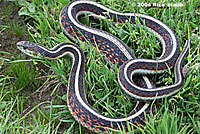|
| Typically-Colored Snakes With Pale or Yellowish Stripes and Undersides |
 |
| Adult with head flattened in defensive display, Monterey County |
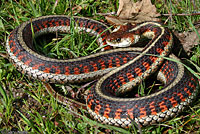 |
 |
 |
 |
Large adult - notice the flattened head defensive display, Monterey County. Photos © Gary Nafis.
Specimen courtesy of David Keegan & Susan Whitford of the Santa Lucia Conservancy. |
Adult, Contra Costa County |
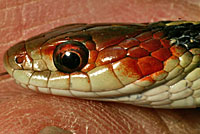 |
 |
 |
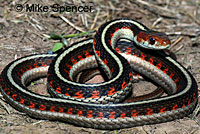 |
| Adult, Humboldt County |
Adult, Mendocino County
© Mike Spencer |
|
 |
 |
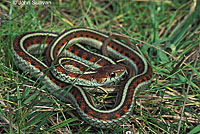 |
| Adult, Solano County, © Rick Staub |
Adult, Fort Ord, Monterey County © K. Moussally |
Adult, Santa Cruz County
© John Sullivan |
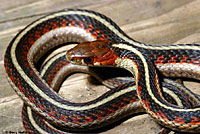 |
 |
 |
 |
| Adult, Humboldt County |
Adult from near Sea Ranch, Sonoma County © Craig Tooley - Ruffimage.com |
Adult, Mendocino County © Luke Talltree |
 |
 |
 |
 |
| Adult, Alameda County © Luke Talltree |
Adult, Sonoma County © Luke Talltree |
Adult, eastern Sonoma County
© egret.org / Audubon Canyon Ranch |
 |
 |
 |
 |
Adult, Alameda County
© David Rodriguez |
Adult, Humboldt County © Spencer Riffle |
Adult, Humboldt County © Spencer Riffle |
 |
 |
 |
 |
Adult, Monterey County
© Benjamin German |
Adult, Napa County © Jonathan Koehler
This snake was found along the Napa River south of Yountville, which is close to where the T. s. infernalis subspecies meets the T. s. fitchi subspecies in Napa County. It looks more like T. s. infernalis to my eye, but some might call it an intergrade due to the fact that the entire head is not red. |
 |
 |
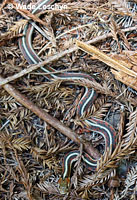 |
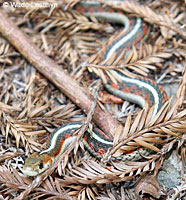 |
| Adult, Alameda County © David Rodriguez |
Adult, Mendocino County © Wade Leschyn |
 |
 |
 |
 |
This adult snake, found in Sonoma County near the Mendocino County border, has an unusual amount of red on the sides that even covers some of the light side stripes.
© Craig Tooley - Ruffimage.com |
This snake from the Humboldt County coast has a mostly solid red stripe on the sides which is more typical of some Coast Gartersnakes © Teejay ORear |
Adult, Contra Costa County
© Faris K |
Adult, Alameda County
© Kevin Hintsa |
 |
 |
|
| This snake from extreme southern Solano County appears to be mix of a Valley Gartersnake and a California red-sided Gartersnake. © Andre Giraldi |
Adult, Santa Clara County © Faris K |
|
|
|
|
|
Snakes With Blueish Coloring on the Stripes and Underside
From north of the San Francisco Bay
(These are similar in coloring to the San Francisco Gartersnake subspecies, but they are a different subspecies.) |
 |
 |
 |
 |
| Adult with blue coloring, coastal Marin County |
Adult, coastal Marin County |
 |
 |
 |
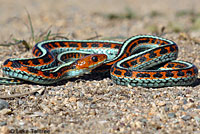 |
| Adult with blue coloring, coastal Marin County |
Adult, Marin County © Luke Talltree |
 |
 |
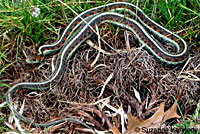 |
 |
| Gravid adult female, coastal Marin County |
Adult, Sonoma County near Santa Rosa
© Suzanne Kennedy |
Adult, with blue stripes, Sonoma County, near Sebastopol. © Nancy Mittasch
|
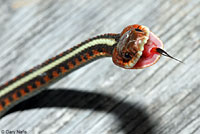 |
 |
 |
 |
| |
Juvenile mouth gaping defensive display, Marin County |
|
 |
 |
 |
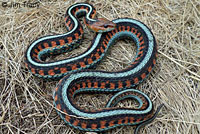 |
| Juvenile, Marin County |
Gravid adult female, Marin County
© Jim Tracy
|
Gravid adult female, Marin County
© Jim Tracy |
 |
 |
 |
 |
| Adult, Marin County © Luke Talltree |
Adult, Marin County © Luke Talltree |
Adult female, Marin County
© Adam Gitmed |
Adult male, Marin County
© Adam Gitmed |
 |
|
|
|
This bluish adult is from southeastern Mendocino County, which might be at the northernmost part of the range where this snake shows some blue coloring. (This snake is also near where the Valley Gartersnake shows up and it shows some characteristics of that subspecies.) © Spencer Riffle
|
|
|
|
| |
|
|
|
Snakes With Blueish Coloring on the Stripes and Underside
Not from north of the San Francisco Bay
(These are similar in coloring to the San Francisco Gartersnake subspecies, but they are a different subspecies.) |
 |
 |
 |
|
Adult with blue coloring, Santa Clara County © Holly Lane
This snake was found sitting on a trail with its head elevated, eyeing a California Kingsnake that was approaching it from some tall grass. Kingsnakes eat other snakes, and this gartersnake knew it. |
Adult, San Benito County
© David Conrath.
This snake is from the southernmost location from which I've seen a snake with this blue coloration - extreme northwestern San Benito County, about 5 miles north of San Juan Bautista, 12 miles from Monterey Bay, and 40 miles as the crow flies from the southernmost known location of the San Francisco Gartersnake. |
This Valley Gartersnake with blue coloring was found in San Benito County near Hollister, which is not far south of where the snake to the left was found.
© Brandon King |
|
 |
 |
 |
|
| Adult, Contra Costa County © Faris K |
Adult, Contra Costa County © Faris K |
Adult, Contra Costa County © Faris K |
|
| |
|
|
|
Comparison With Sympatric Gartersnake Species
(California Gartersnakes Identification Key) |
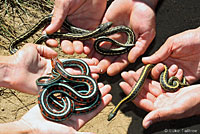 |
 |
 |
|
Three species of gartersnakes found at the same Marin County location:
Right - Thamnophis atratus
Bottom left - Thamnophis sirtalis
Top - Thamnophis elegans
© Luke Talltree |
Three species of gartersnakes found at the same Marin County location:
Top - Thamnophis sirtalis
Middle - Thamnophis elegans
Bottom - Thamnophis atratus
© Zach Lim |
Looking at the top of the heads can help to identify these sympatric species on the north coast:
T. sirtalis - Common Gartersnake (Left) has a larger longer head with bigger eyes than
T. ordinoides - Northwestern Gartersnake (Right.)
© Filip Tkaczyk |
|
| |
|
|
|
| Habitat |
 |
 |
 |
 |
| Habitat, Alameda County |
Habitat in winter, Monterey County |
Habitat, Marin County |
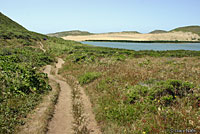 |
 |
 |
 |
Habitat, Marin County
|
Habitat, Marin County |
Habitat, Humboldt County |
Habitat, Humboldt County |
 |
 |
 |
|
| Coastal habitat, Humboldt County |
Adult in habitat, Alameda County |
Habitat, Humboldt County coast
© Teejay ORear |
|
| |
|
|
|
| Short Videos |
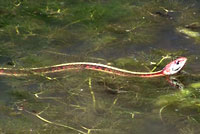 |
 |
 |
|
| A red-sided gartersnake swims around in a small cattle pond on a sunny spring afternoon in Alameda County. I wanted to get a closer look, so I walked over to the snake's side of the pond, but then it swam to the other side, again and again, until I got tired of going round in circles. |
A huge feisty Red-sided Gartersnake from Santa Barbara County strikes out a few times at its captor.
Video © Vince Semonsen
|
A juvenile CA red-sided gartersnake in Marin County. |
|
|
|
|
|
Description |
Not Dangerous - This snake may produce a mild venom that does not typically cause death or serious illness or injury in most humans, but its bite should be avoided.
Commonly described as "harmless" or "not poisonous" to indicate that its bite is not dangerous, but "not venomous" is more accurate since the venom is not dangerous. (A poisonous snake can hurt you if you eat it. A venomous snake can hurt you if it bites you.)
Long-considered non-venomous, discoveries in the early 2000s revealed that gartersnakes produce a mild venom that can be harmfull to small prey but is not considered dangerous to most humans, although a bite may cause slight irritation and swelling around the puncture wound. Enlarged teeth at the rear of the mouth are thought to help spread the venom.
|
| Size |
Adults of this species measure 18 - 55 inches in length (46 - 140 cm), but the average size is under 36 inches (91 cm).
|
| Appearance |
A medium-sized snake with a head barely wider than the neck and keeled dorsal scales.
The eyes are relatively larged compared with other gartersnake species.
Some average scale counts:
7, occasionally 8, rarely 6 or 9, upper labial scales, often with black wedges.
10 lower labial scales.
The rear pair of chin shields are longer than the front.
Average of 19 scales at mid-body. |
| Color and Pattern |
Ground color is dark olive to black.
The dorsal stripe is wide and well-defined, and yellowish to bluish in color.
Light stripes along the lower sides are not very distinct, often blending in with the color of the belly.
There are red bars alternating with the ground color along the sides above the lateral stripes.
The head is red or orangish.
The underside is bluish gray, sometimes with dark markings.
Snakes with robin's-egg-blue stripes and blue underneath are found north of the Bay Area into Sonoma County at least as far north as Sebastapol and Santa Rosa. Snakes from Sea Ranch in Sonoma county lack the blue, so the transition takes place somewhere between Sebastapol and Sea Ranch.
Some snakes in the southern part of the Bay Area may have bluish coloring with a yellow dorsal stripe. |
Key to Identifying California Gartersnake Species
|
| Life History and Behavior |
Activity |
Primarily active during daylight.
A good swimmer.
The species T. sirtalis is capable of activity at lower temperatures than other species of North American snake. |
| Defense |
Often escapes into water when threatened.
When first handled, typical of gartersnakes, this snake often releases cloacal contents and musk, and strikes. |
| Diet and Feeding |
Eats a wide variety of prey, including frogs and newts and their larvae, fish, birds, and their eggs, small mammals, reptiles, earthworms, slugs, and leeches.
Toxic Newts
This species is able to eat adult Pacific Newts (genus Taricha) which are deadly poisonous to most predators.
An arms race between T. sirtalis and the tetrodoxin poison contained in Taricha has been documented, with newt toxicity varying by location and snake resistance to the toxin also varying by location.
(Edmund D. Brodie III. Patterns, Process, and the Parable of the Coffeepot Incident: Arms Races Between Newts and Snakes from Landscapes to Molecules. From In the Light of Evolution: Essays from the Laboratory and Field edited by Jonathan Losos (Roberts and Company Publishers). 2010.)
The Bay Area is the Center of an Evolutionary Race Between Hungry Snakes and Toxic Newts.
by Anton Sorokin. Bay Nature, April 6, 2022
Gartersnakes Can Become Poisonous
There is evidence that when Common Gartersnakes (Thamnophis sirtalis) eat Rough-skinned Newts (Taricha granulosa) they retain the deadly neurotoxin found in the skin of the newts called tetrodotoxin for several weeks, making the snakes poisonous (not venomous) to predators (such as birds or mammals) that eat the snakes. Since California Newts (Taricha torosa) also contain tetrodotoxin in their skin, and since gartersnake species other than T. sirtalis also eat newts, it is not unreasonable to conclude that any gartersnake that eats either species of newt is poisonous to predators.
Williams, Becky L.; Brodie, Edmund D. Jr.; Brodie, Edmund D. III (2004). "A Resistant Predator and Its Toxic Prey: Persistence of Newt Toxin Leads to Poisonous (Not Venomous) Snakes." Journal of Chemical Ecology. 30 (10): 1901–1919.) https://doi.org/10.1023/B:JOEC.0000045585.77875.09
|
| Reproduction |
Females are ovoviviparous. After mating with a male they carry the eggs internally until the young are born live.
According to *Rossman et al. 1996, although Fall mating has been observed, most mating occurs in the Spring and most data for the species suggest that offspring are born some time between midsummer and early Fall, with considerable variation among and within populations.
|
| Habitat |
Utilizes a wide variety of habitats - forests, mixed woodlands, grassland, chaparral, farmlands, often near ponds, marshes, or streams.
|
| Geographical Range |
The species Thamnophis sirtalis - Common Gartersnake, has the largest distribution of any gartersnake, ranging from the east coast to the west coast and north into Canada, farther north than any other species of snake in North America.
This subspecies, Thamnophis sirtalis infernalis - California Red-sided Gartersnake, is endemic to California, ranging from Humboldt County south, along the North Coast ranges (excluding much of the San Francisco peninsula) and east of the San Francisco Bay, then south along the central and south coasts to San Diego County.
(The eastern edge of the range of this subspecies as shown on my distribution maps is approximate and subject to change. For example: after I learned that an example of this subspecies was found on the east side of San Luis Reservoir in Merced County, I expanded the range east to cover that area. It's also possible there is a wide area of intergradation where both subspecies can be found. Researchers are no longer concerned with subspecies, so there is little information for me to go by.)
Common Gartersnakes from the Santa Clara River area in Ventura County south, may prove to be a new species (Stebbins 2003). I have followed the California Dept. of Fish and Wildlife's designation of these south coast snakes by indicating them separatley on the map, but grouping then with T. s. infernalis until more research proves otherwise. (See notes on taxonomy below about the South Coast Gartersnake.)
Uncertainty about which subspecies is present on the Central Coast between Monterey and Ventura Counties.
I have been uncertain about which subspecies is present in this area, T. s. infernalis or T. s. fitchi. Field guides show either one or the other in the area, but they don't show it as a range of intergradation where both subspecies can be found. I have heard from a reliable source that a respected herpetologist working in the area told him that the Common Gartersnakes within 5-10 miles of the Central Coast are T. s. infernalis, but I have not seen any pictures of them to confirm this. This picture shows a Common Gartersnake found 3 miles from the coast in San Luis Obispo County that has no red on the head, similar to T. s. fitchi. However, it also has large bright red spots on the sides that make it look more like T. s. infernalis, so it's possible the area near the coast is an intergrade area where snakes resembling either subspecies can be found.
Robert Stebbins, in his 1985, 2003, and 2018 western field guides, shows T. s. infernalis as the subspecies present along almost the entire coast with two areas in question in Ventura and Orange/San Diego counties. (His 2012 field guide does not show any subspecies of T. sirtalis.) My older range maps on this site showed
T. s. infernalis distributed along almost the entire coast, following Stebbins (and before the South Coast Gartersnake was recoginzed by the California Department of Fish and Wildlife) but I changed it first to show intergrades on the Central Coast, then I changed it again to show only T. s. fitchi on the Central Coast for these reasons:
- Rossman et al. in The Garter Snakes - Evolution and Ecology 1996 * show T. s. fitchi as the subspecies present along the central coast from south of Monterey Bay to Santa Barbara County.
- In a 2002 study of western T. sirtalis, Janzen et al show T. s. fitchi as present in the area.
- A herpetologist who has surveyed the area told me that snakes in the area he has found have all keyed out to be T. s. fitchi - from the Salinas Valley south to Vandenburgh AFB in Santa Barbara County.
- I have seen several specimens from the area that were clearly T. s. fitchi, including one from right on the coast at San Simeon;
- All of the pictures of common gartersnakes in the area I have seen that can be identified look like T. s. fitchi, but none look like T. s. infernalis, including pictures I've looked at on iNaturalist and in the H.E.R.P. database. (Some are labled T. s. infernalis, but that is not evident from the pictures);
I don't have the resources to do a survey for snakes in the entire area or to check all of the museum specimens from the area, but until I see evidence that
T. s. infernalis also inhabits the area I'll show only T. s. fitchi, which I know is there. If you have seen pictures or other evidence of a snake that is clearly T. s. infernalis inhabiting the area, please let me know.
|
 |
| Elevational Range |
Rossman et al (1996) show the elevation record for the species (not specifically this subspecies) at 8,333 feet (2540 m.). Stebbins (2003) shows it as
8,000 ft. (2,438 m).
|
| Notes on Taxonomy |
SSAR Herpetological Circular No. 43, 2017 shows this note regarding the species Thamnophis sirtalis: "Analyses of mitochondrial and nuclear data suggest that this species may be composed of multiple independently evolving lineages often not concordant with the subspecific taxonomy (F. Burbrink, pers. comm.)."
----------------------------------------------------------------------------------------------------------------------------------------------------------------------------------------------------------------------------
In 1995, Doug Rossman and Jeff Boundy re-named the Thamnophis sirtalis found on the San Francisco Peninsula T. s. infernalis, (removing the name T. s. tetrataenia, but recognizing that the snakes were still subspecifically distinct), and lumped the coastal T. sirtalis with T. s. concinnus. This taxonomy is shown on the range map in the 1996 book, The Garter Snakes - Evolution and Ecology 1. In 1998, Sean Barry and Mark Jennings petitioned the International Commission on Zoological Nomenclature (ICZN) to restore the previous nomenclature 2. With no opposition from Boundy or Rossman, the ICZN agreed to restore the name T. s. tetrataenia to Common Gartersnakes on the San Francisco peninsula 3. Nevertheless, some authors either missed the restoration of this nomenclature or chose to ignore it, and their work still reflects Rossman and Boundy's nomenclature.
(Thanks to Sean Barry for this clarification in a personal communication.)
Robert Stebbins and Samuel M. McGinnis, in their 2018 Field Guide to Western Reptiles & Amphibians mention that southern Calfiornia populations of T. sirtalis, from the Santa Clara River area in Ventura County south, may prove to be a new species.
Alternate and Previous Names (Synonyms)
Thamnophis sirtalis infernalis - California Red-sided Garter Snake (Stebbins 1966, 1985, 2003, Stebbins & McGinnis 2012)
Thamnophis sirtalis infernalis (Stebbins 1954)
Thamnophis sirtalis parietalis - Western Garter Snake (Coluber parietalis; Coluber infernalis; Eutaenia sirtalis obscura; Eutaenia sirtalis; Tropidonotus parietalis; Eutaenia proxima; Eutaenia imperialia; Eutaenia sirtalis pickeringii; Thamnophis infernalis, part; Thamnophis elegans, part; Eutaenia concinna; Thamnophis parietalis; Eutaenia sirtalis parietalis; Eutaenia sirtalis tetrataenia; Eutaenia sirtalis dorsalis. Pacific Garter Snake; Rocky Mountain Garter Snake; Red-barred Garter Snake; California Garter Snake; Churchill's Garter Snake; Dusky Garter Snake; Say's Garter Snake; Striped Snake; Pickering's Garter Snake) (Grinnell and Camp 1917)
Pacific garter snake
California-red-barred garter snake
One-striped garter snake
Single-striped garter snake
|
| Conservation Issues (Conservation Status) |
None.
South Coast Gartersnake Conservation Issues
|
|
| Taxonomy |
| Family |
Colubridae |
Colubrids |
Oppel, 1811 |
| Genus |
Thamnophis |
North American Gartersnakes |
Fitzinger, 1843 |
| Species |
sirtalis |
Common Gartersnake |
(Linnaeus, 1758) |
Subspecies
|
infernalis |
Red-sided Gartersnake |
(Blainville, 1835) |
|
Original Description |
Thamnophis sirtalis - (Linnaeus, 1758) - Syst. Nat., 10th ed., Vol. 1, p. 222
Thamnophis sirtalis infernalis - (Blainville, 1835) - Nouv. Ann. Mus. Hist. Nat. Paris, Vol. 4, p. 291, pl. 26, fig. 3
from Original Description Citations for the Reptiles and Amphibians of North America © Ellin Beltz
|
|
Meaning of the Scientific Name |
Thamnophis - Greek - thamnos - shrub or bush, and ophis - snake, serpent
sirtalis - Latin - like a garter - probably refers to the to striped pattern
infernalis - Latin - of hell
from Scientific and Common Names of the Reptiles and Amphibians of North America - Explained © Ellin Beltz
It is often reported that the name "garter snake" comes from the snake's striped back, which resembles the garters that were once used to hold up men's socks. In Etymology of garter snake evolutionary biologist Colin Purrington posits that "sirtalis" does not mean "like a garter" it means something closer to "ropelike." It follows that "garter snake" does not refer to the appearance of a man's garter, it is more likely "...a misspelling of guarder snake, garden snake, gardener snake, or garten snake."
|
|
Other California Garternakes |
T. a. atratus - Santa Cruz Gartersnake
T. a. hydrophilus - Oregon Gartersnake
T. a. zaxanthus - Diablo Range Gartersnake
T. couchii - Sierra Gartersnake
T. gigas - Giant Gartersnake
T. e. elegans - Mountain Gartersnake
T. e. terrestris - Coast Gartersnake
T. e. vagrans - Wandering Gartersnake
T. hammondii - Two-striped Gartersnake
T. m. marcianus - Marcy's Checkered Gartersnake
T. ordinoides - Northwestern Gartersnake
T. s. fitchi - Valley Gartersnake
T. s. tetrataenia - San Francisco Gartersnake
|
|
More Information and References |
California Department of Fish and Wildlife
* Rossman, Douglas A., Neil B, Ford, & Richard A. Siegel. The Garter Snakes - Evolution and Ecology. University of Oklahoma press, 1996.
Hansen, Robert W. and Shedd, Jackson D. California Amphibians and Reptiles. (Princeton Field Guides.) Princeton University Press, 2025.
Stebbins, Robert C., and McGinnis, Samuel M. Field Guide to Amphibians and Reptiles of California: Revised Edition (California Natural History Guides) University of California Press, 2012.
Stebbins, Robert C. California Amphibians and Reptiles. The University of California Press, 1972.
Flaxington, William C. Amphibians and Reptiles of California: Field Observations, Distribution, and Natural History. Fieldnotes Press, Anaheim, California, 2021.
Samuel M. McGinnis and Robert C. Stebbins. Peterson Field Guide to Western Reptiles & Amphibians. 4th Edition. Houghton Mifflin Harcourt Publishing Company, 2018.
Stebbins, Robert C. A Field Guide to Western Reptiles and Amphibians. 3rd Edition. Houghton Mifflin Company, 2003.
Behler, John L., and F. Wayne King. The Audubon Society Field Guide to North American Reptiles and Amphibians. Alfred A. Knopf, 1992.
Powell, Robert., Joseph T. Collins, and Errol D. Hooper Jr. A Key to Amphibians and Reptiles of the Continental United States and Canada. The University Press of Kansas, 1998.
Bartlett, R. D. & Patricia P. Bartlett. Guide and Reference to the Snakes of Western North America (North of Mexico) and Hawaii. University Press of Florida, 2009.
Bartlett, R. D. & Alan Tennant. Snakes of North America - Western Region. Gulf Publishing Co., 2000.
Brown, Philip R. A Field Guide to Snakes of California. Gulf Publishing Co., 1997.
Ernst, Carl H., Evelyn M. Ernst, & Robert M. Corker. Snakes of the United States and Canada. Smithsonian Institution Press, 2003.
Taylor, Emily. California Snakes and How to Find Them. Heyday, Berkeley, California. 2024.
Wright, Albert Hazen & Anna Allen Wright. Handbook of Snakes of the United States and Canada. Cornell University Press, 1957.
Robert C. Thomson, Amber N. Wright, and H. Bradley Shaffer. California Amphibian and Reptile Species of Special Concern. University of California Press, 2016.
Fredric J. Janzen, James G. Krenz, Tamara S. Haselkorn, Edmund D. Brodie, Jr, and Edmund D. Brodie, III. Molecular phylogeography of common garter snakes (Thamnophis sirtalis) in western North America: implications for regional historic forces. Molecular Ecology (2002) 11, 1739-1751. © 2002 Blackwell Science Ltd
Joseph Grinnell and Charles Lewis Camp. A Distributional List of the Amphibians and Reptiles of California. University of California Publications in Zoology Vol. 17, No. 10, pp. 127-208. July 11, 1917.
|
|
|
The following conservation status listings for this animal are taken from the April 2024 State of California Special Animals List and the April 2024 Federally Listed Endangered and Threatened Animals of California list (unless indicated otherwise below.) Both lists are produced by multiple agencies every year, and sometimes more than once per year, so the conservation status listing information found below might not be from the most recent lists. To make sure you are seeing the most recent listings, go to this California Department of Fish and Wildlife web page where you can search for and download both lists:
https://www.wildlife.ca.gov/Data/CNDDB/Plants-and-Animals.
A detailed explanation of the meaning of the status listing symbols can be found at the beginning of the two lists. For quick reference, I have included them on my Special Status Information page.
If no status is listed here, the animal is not included on either list. This most likely indicates that there are no serious conservation concerns for the animal. To find out more about an animal's status you can also go to the NatureServe and IUCN websites to check their rankings.
Check the current California Department of Fish and Wildlife sport fishing regulations to find out if this animal can be legally pursued and handled or collected with possession of a current fishing license. You can also look at the summary of the sport fishing regulations as they apply only to reptiles and amphibians that has been made for this website.
The species T. sirtalis is not included on the California Special Animals List, which indicates that there are no significant conservation concerns for it.
|
| Organization |
Status Listing |
Notes |
| NatureServe Global Ranking |
None |
|
| NatureServe State Ranking |
None |
|
| U.S. Endangered Species Act (ESA) |
None |
|
| California Endangered Species Act (CESA) |
None |
|
| California Department of Fish and Wildlife |
None |
|
| Bureau of Land Management |
None |
|
| USDA Forest Service |
None |
|
| IUCN |
None |
|
|
|

























































































